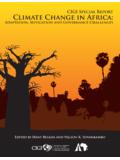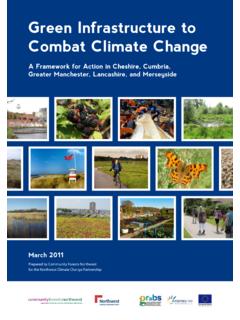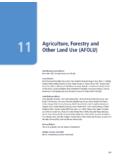Transcription of THE OECD ENVIRONMENTAL OUTLOOK TO 2050 Key …
1 November 2012 THE OECD ENVIRONMENTAL OUTLOOK TO 2050 Key Findings on Climate change Trends and projections: we are far off course ENVIRONMENTAL state and pressures Global greenhouse gas (GHG) emissions continue to increase, and in 2010 global energy-related carbon dioxide (CO2) emissions reached an all-time high of gigatonnes (Gt) despite the recent economic crisis. The ENVIRONMENTAL OUTLOOK Baseline scenario envisages that without more ambitious policies than those in force today, GHG emissions will increase by another 50% by 2050, primarily driven by a projected 70% growth in CO2 emissions from energy use.
2 This is primarily due to a projected 80% increase in global energy demand. Transport emissions are projected to double due to a strong increase in demand for cars in developing countries and aviation. Historically, OECD economies have been responsible for most of the emissions. In the coming decades, increasing emissions will also be caused by high economic growth in some of the major emerging economies. GHG emissions by region (in GtCO2e): Baseline scenario Note: GtCO2e = Giga tonnes of CO2 equivalent ROW = Rest of the World Source: OECD ENVIRONMENTAL OUTLOOK Baseline; ENV-Linkages model Global GHG emissions are expected to grow by 50% between now and 2050, mostly driven by energy demand and economic growth in key emerging economies Without more ambitious policies, the Baseline projects that atmospheric concentration of GHG would reach almost 685 parts per million (ppm) CO2-equivalents by 2050.
3 This is well over the concentration level of 450 ppm required to have at least a 50% chance of stabilising the climate at 2 degrees (2 C) global average temperature increase, the goal set in 2010 at the UN Framework Convention on Climate change (UNFCCC) conference in Canc n. Under the Baseline projection, global average temperature is likely to exceed this goal by 2050, and by 3 to 6oC higher than pre-industrial levels by the end of the century. Such a high temperature increase 2 would continue to alter precipitation patterns, melt glaciers, cause sea-level rise and intensify extreme weather events to unprecedented levels.
4 It might also exceed some critical tipping-points , causing dramatic natural changes that could have catastrophic or irreversible outcomes for natural systems and society. Long-run CO2 concentrations and temperature increase: Baseline, 1980-2100 Source: The OECD ENVIRONMENTAL OUTLOOK Baseline projections; IMAGE model change in annual temperature 1990-2050: Baseline scenario Source: The OECD ENVIRONMENTAL OUTLOOK Baseline projections; IMAGE model Technological progress and structural shifts in the composition of growth are projected to improve the energy intensity of economies in the coming decades ( achieving a relative decoupling of GHG emissions growth and GDP growth), especially in OECD and the emerging economies of Brazil, Russia, India, Indonesia, China and South Africa (BRIICS).
5 However, under current trends, these regional improvements would be outstripped by the increased energy demand worldwide. 3 Emissions from land use, land use change and forestry (LULUCF) are projected to decrease in the course of the next 30 years, while carbon sequestration by forests increases. By 2045, net CO2 emissions from land use are projected to become negative in OECD countries become a net emissions sink. Most emerging economies also show a decreasing trend in emissions from an expected slowing of deforestation.
6 In the rest of the world, land use emissions are projected to increase to 2050, driven by expanding agricultural areas, particularly in Africa. Policy responses Pledging action to achieve national GHG emission reduction targets and actions under the UNFCCC at Copenhagen and Canc n was an important step by countries in finding a global solution. However, the mitigation actions pledged by countries are not enough to be on a least-cost pathway to meet the 2 C goal. Limiting temperature increase to 2 C from these pledges would incur substantial additional costs after 2020 to ensure that atmospheric concentrations of GHGs do not exceed 450 ppm by the end of the century.
7 More ambitious action is therefore needed now and post-2020. For example, 80% of the projected emissions from the power sector in 2020 are inevitable, as they come from power plants that are already in place or are being built today. The world is locking itself into high-carbon systems more strongly every year. Prematurely closing plants at significant economic cost would be the only way to reverse this lock-in . Progress has been made in developing national strategies for adapting to climate change . These also encourage the assessment and management of climate risk in relevant sectors.
8 However, there is still a long way to go before the right instruments and institutions are in place to explicitly incorporate climate change risk into policies and projects, increase private-sector engagement in adaptation actions and integrate climate change adaptation into development co-operation. How can we avoid the grim prospects? We must act now to reverse emission trends projected under the Baseline scenario in order to stabilise GHG concentrations at 450 ppm CO2e and increase the chance of limiting the global average temperature increase to 2 C.
9 Delayed or only moderate action up to 2020 (such as going no further than implementing the Copenhagen/Canc n pledges, or waiting for better technologies to come on stream) would be more costly. It would increase the pace and scale of efforts needed after 2020, and also entail higher ENVIRONMENTAL risk. This OUTLOOK explores three different scenarios for stabilising emissions at 450 ppm by the end of the 21st century: 450 ppm Core scenario: least-cost timing of action (immediately tapping into less costly mitigation options in all sectors, regions and gases; use of low-cost mitigation technologies biomass energy with carbon capture and storage [BECCS] that become available later this century), start pricing carbon in 2013.
10 Accelerated Action scenario: assumptions as in the 450 Core scenario, but with steeper mitigation efforts between 2013 and 2030 to reduce reliance on emerging new technologies like BECCS in later decades. Delayed Action scenario: mitigation action limited to Canc n and Copenhagen pledges to 2020; fragmented regional carbon markets between 2013 and 2020; requires rapid, costly and significant Copenhagen/Cancun pledges are not enough. 4 catch up after 2020 involving premature scrapping or retrofitting of existing fossil energy infrastructure that are locked in.















![Home [www4.unfccc.int]](/cache/preview/f/1/c/d/7/9/9/0/thumb-f1cd7990e2e0f9d979c349afb9603733.jpg)